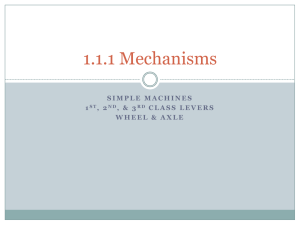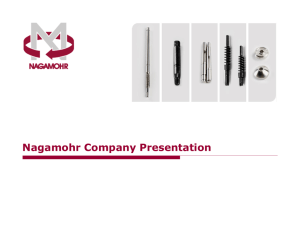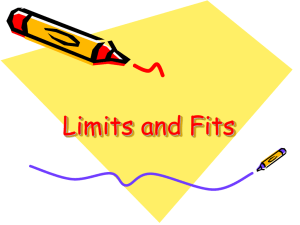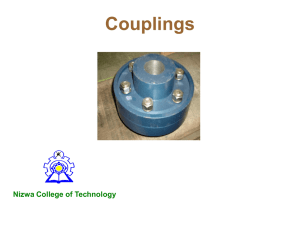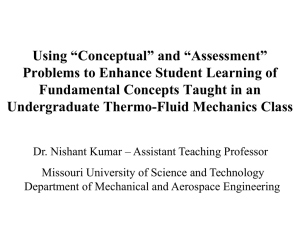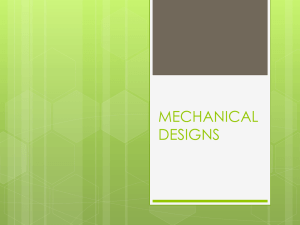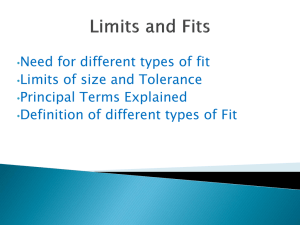Shafts subjected to combined twisting and
advertisement
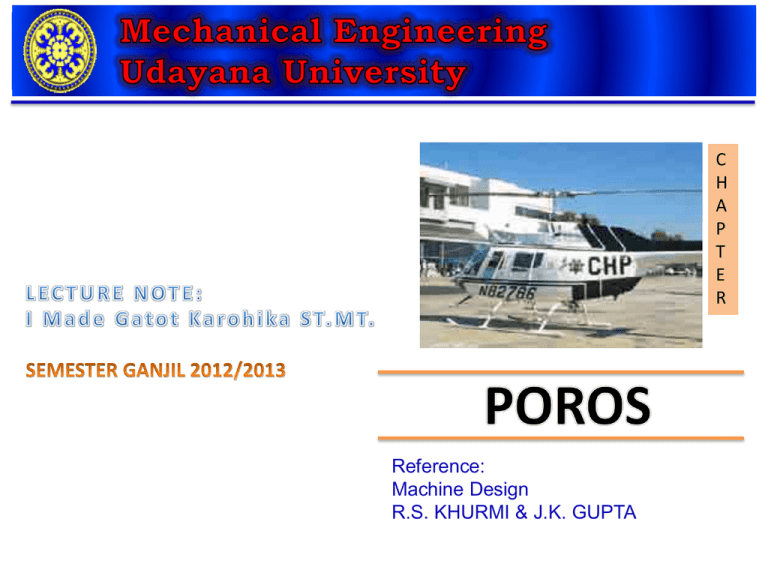
C H A P T E R Reference: Machine Design R.S. KHURMI & J.K. GUPTA Introduction A shaft is a rotating machine element which is used to transmit power from one place to another. The power is delivered to the shaft by some tangential force and the resultant torque (or twisting moment) set up within the shaft permits the power to be transferred to various machines linked up to the shaft. In order to transfer the power from one shaft to another, the various members such as pulleys, gears etc., are mounted on it. These members along with the forces exerted upon them causes the shaft to bending. In other words, we may say that a shaft is used for the transmission of torque and bending moment. The various members are mounted on the shaft by means of keys or splines. Notes: 1. The shafts are usually cylindrical, but may be square or cross-shaped in section. They are solid in cross-section but sometimes hollow shafts are also used. 2. An axle, though similar in shape to the shaft, is a stationary machine element and is used for the transmission of bending moment only. It simply acts as a support for some rotating body such as hoisting drum, a car wheel or a rope sheave. 3. A spindle is a short shaft that imparts motion either to a cutting tool (e.g. drill press spindles) or to a work piece (e.g. lathe spindles). Material Used for Shafts The material used for shafts should have the following properties : 1. It should have high strength. 2. It should have good machinability. 3. It should have low notch sensitivity factor. 4. It should have good heat treatment properties. 5. It should have high wear resistant properties. The material used for ordinary shafts is carbon steel of grades 40 C 8, 45 C 8, 50 C 4 and 50 C 12. The mechanical properties of these grades of carbon steel are given in the following table. When a shaft of high strength is required, then an alloy steel such as nickel, nickel-chromium or chrome-vanadium steel is used. Manufacturing of Shafts Shafts are generally manufactured by hot rolling and finished to size by cold drawing or turning and grinding. The cold rolled shafts are stronger than hot rolled shafts but with higher residual stresses. The residual stresses may cause distortion of the shaft when it is machined, especially when slots or keyways are cut. Shafts of larger diameter are usually forged and turned to size in a lathe. Types of Shafts The following two types of shafts are important from the subject point of view : 1. Transmission shafts. These shafts transmit power between the source and the machines absorbing power. The counter shafts, line shafts, over head shafts and all factory shafts are transmission shafts. Since these shafts carry machine parts such as pulleys, gears etc., therefore they are subjected to bending in addition to twisting. 2. Machine shafts. These shafts form an integral part of the machine itself. The crank shaft is an example of machine shaft. Standard Sizes of Transmission Shafts The standard sizes of transmission shafts are : 25 mm to 60 mm with 5 mm steps; 60 mm to 110 mm with 10 mm steps ; 110 mm to 140 mm with 15 mm steps ; and 140 mm to 500 mm with 20 mm steps. The standard length of the shafts are 5 m, 6 m and 7 m. Stresses in Shafts The following stresses are induced in the shafts : 1. Shear stresses due to the transmission of torque (i.e. due to torsional load). 2. Bending stresses (tensile or compressive) due to the forces acting upon machine elements like gears, pulleys etc. as well as due to the weight of the shaft itself. 3. Stresses due to combined torsional and bending loads. Maximum Permissible Working Stresses for Transmission Shafts According to American Society of Mechanical Engineers (ASME) code for the design of transmission shafts, the maximum permissible working stresses in tension or compression may be taken as (a) 112 MPa for shafts without allowance for keyways. (b) 84 MPa for shafts with allowance for keyways. For shafts purchased under definite physical specifications, the permissible tensile stress (σt) may be taken as 60 percent of the elastic limit in tension (σel), but not more than 36 per cent of the ultimate tensile strength (σu). In other words, the permissible tensile stress, σt = 0.6 σel or 0.36 σu, whichever is less. The maximum permissible shear stress may be taken as (a) 56 MPa for shafts without allowance for key ways. (b) 42 MPa for shafts with allowance for keyways. For shafts purchased under definite physical specifications, the permissible shear stress (τ) may be taken as 30 per cent of the elastic limit in tension (σel) but not more than 18 percent of the ultimate tensile strength (σu). In other words, the permissible shear stress, τ = 0.3 σel or 0.18 σu, whichever is less. Design of Shafts The shafts may be designed on the basis of 1. Strength, and 2. Rigidity and stiffness. In designing shafts on the basis of strength, the following cases may be considered : (a) Shafts subjected to twisting moment or torque only, (b) Shafts subjected to bending moment only, (c) Shafts subjected to combined twisting and bending moments, and (d) Shafts subjected to axial loads in addition to combined torsional and bending loads. We shall now discuss the above cases, in detail, in the following pages. Shafts Subjected to Twisting Moment Only When the shaft is subjected to a twisting moment (or torque) only, then the diameter of the shaft may be obtained by using the torsion equation. We know that ...(i) where T = Twisting moment (or torque) acting upon the shaft, J = Polar moment of inertia of the shaft about the axis of rotation, τ = Torsional shear stress, and r = Distance from neutral axis to the outer most fibre = d / 2; where d is the diameter of the shaft. We know that for round solid shaft, polar moment of inertia, The equation (i) may now be written as ...(ii) From this equation, we may determine the diameter of round solid shaft ( d ). We also know that for hollow shaft, polar moment of inertia, where do and di = Outside and inside diameter of the shaft, and r = do / 2. Substituting these values in equation (i), we have ...(iii) Let k = Ratio of inside diameter and outside diameter of the shaft = di / do Now the equation (iii) may be written as ...(iv) From the equations (iii) or (iv), the outside and inside diameter of a hollow shaft may be determined. It may be noted that 1. The hollow shafts are usually used in marine work. These shafts are stronger per kg of material and they may be forged on a mandrel, thus making the material more homogeneous thanwould be possible for a solid shaft. When a hollow shaft is to be made equal in strength to a solid shaft, the twisting moment of both the shafts must be same. In other words, for the same material of both the shafts, 2. The twisting moment (T) may be obtained by using the following relation : We know that the power transmitted (in watts) by the shaft, where T = Twisting moment in N-m, and N = Speed of the shaft in r.p.m. 3. In case of belt drives, the twisting moment ( T ) is given by T = (T1 – T2 ) R where T1 and T2 = Tensions in the tight side and slack side of the belt respectively, and R = Radius of the pulley. Example 1 A line shaft rotating at 200 r.p.m. is to transmit 20 kW. The shaft may be assumed to be made of mild steel with an allowable shear stress of 42 MPa. Determine the diameter of the shaft, neglecting the bending moment on the shaft. Solution. Given : N = 200 r.p.m. ; P = 20 kW = 20 × 103 W; τ = 42 MPa = 42 N/mm2 Let d = Diameter of the shaft. We know that torque transmitted by the shaft, We also know that torque transmitted by the shaft ( T ), Example 2. A solid shaft is transmitting 1 MW at 240 r.p.m. Determine the diameter of the shaft if the maximum torque transmitted exceeds the mean torque by 20%. Take the maximum allowable shear stress as 60 MPa. Solution. Given : P = 1 MW = 1 × 106 W ; N = 240 r.p.m. ; Tmax = 1.2 Tmean ; τ = 60 MPa = 60 N/mm2 Let d = Diameter of the shaft. We know that mean torque transmitted by the shaft, Maximum torque transmitted, Tmax = 1.2 Tmean = 1.2 × 39 784 × 10 3= 47 741 × 103 N-mm We know that maximum torque transmitted (Tmax), Example 3. Find the diameter of a solid steel shaft to transmit 20 kW at 200 r.p.m. The ultimate shear stress for the steel may be taken as 360 MPa and a factor of safety as 8. If a hollow shaft is to be used in place of the solid shaft, find the inside and outside diameter when the ratio of inside to outside diameters is 0.5. Solution. Given : P = 20 kW = 20 × 103 W ; N = 200 r.p.m. ; τu = 360 MPa = 360 N/mm2 ; F.S. = 8 ; k = di / do = 0.5 We know that the allowable shear stress, Diameter of the solid shaft Let d = Diameter of the solid shaft. We know that torque transmitted by the shaft, We also know that torque transmitted by the solid shaft (T), Diameter of hollow shaft Let di = Inside diameter, and do = Outside diameter. We know that the torque transmitted by the hollow shaft ( T ), Shafts Subjected to Bending Moment Only When the shaft is subjected to a bending moment only, then the maximum stress (tensile or compressive) is given by the bending equation. We know that ...(i) where M = Bending moment, I = Moment of inertia of cross-sectional area of the shaft about the axis of rotation, σb = Bending stress, and y = Distance from neutral axis to the outer-most fibre. We know that for a round solid shaft, moment of inertia, Substituting these values in equation (i), we have From this equation, diameter of the solid shaft (d) may be obtained. We also know that for a hollow shaft, moment of inertia, Again substituting these values in equation (i), we have From this equation, the outside diameter of the shaft (do) may be obtained. Example 4. A pair of wheels of a railway wagon carries a load of 50 kN on each axle box, acting at a distance of 100 mm outside the wheel base. The gauge of the rails is 1.4 m. Find the diameter of the axle between the wheels, if the stress is not to exceed 100 MPa. Solution. Given : W = 50 kN = 50 × 103 N ; L = 100 mm ; x = 1.4 m ; σb = 100 MPa = 100 N/mm2 The axle with wheels is shown in Fig. 1. A little consideration will show that the maximum bending moment acts on the wheels at C and D. Therefore maximum bending moment, *M = W.L = 50 × 103 × 100 = 5 × 106 N-mm The maximum B.M. may be obtained as follows : RC = RD = 50 kN = 50 × 103 N B.M. at A, MA = 0 B.M. at C, MC = 50 × 103 × 100 = 5 × 106 N-mm B.M. at D, MD = 50 × 103 × 1500 – 50 × 103 × 1400 = 5 × 106 N-mm B.M. at B, MB = 0 Let d = Diameter of the axle. We know that the maximum bending moment (M), Shafts Subjected to Combined Twisting Moment and Bending Moment When the shaft is subjected to combined twisting moment and bending moment, then the shaft must be designed on the basis of the two moments simultaneously. Various theories have been suggested to account for the elastic failure of the materials when they are subjected to various types of combined stresses. The following two theories are important from the subject point of view : 1. Maximum shear stress theory or Guest's theory. It is used for ductile materials such as mild steel. 2. Maximum normal stress theory or Rankine’s theory. It is used for brittle materials such as cast iron. Let τ = Shear stress induced due to twisting moment, and σb = Bending stress (tensile or compressive) induced due to bending moment. According to maximum shear stress theory, the maximum shear stress in the shaft, Substituting the values of τ and σb from Art. 14.9 and Art. 14.10, we have Example 5. A solid circular shaft is subjected to a bending moment of 3000 N-m and a torque of 10 000 N-m. The shaft is made of 45 C 8 steel having ultimate tensile stress of 700 MPa and a ultimate shear stress of 500 MPa. Assuming a factor of safety as 6, determine the diameter of the shaft. Example 6. A shaft supported at the ends in ball bearings carries a straight tooth spur gear at its mid span and is to transmit 7.5 kW at 300 r.p.m. The pitch circle diameter of the gear is 150 mm. The distances between the centre line of bearings and gear are 100 mm each. If the shaft is made of steel and the allowable shear stress is 45 MPa, determine the diameter of the shaft. Show in a sketch how the gear will be mounted on the shaft; also indicate the ends where the bearings will be mounted? The pressure angle of the gear may be taken as 20°. Example 8. A line shaft is driven by means of a motor placed vertically below it. The pulley on the line shaft is 1.5 metre in diameter and has belt tensions 5.4 kN and 1.8 kN on the tight side and slack side of the belt respectively. Both these tensions may be assumed to be vertical. If the pulley be overhang from the shaft, the distance of the centre line of the pulley from the centre line of the bearing being 400 mm, find the diameter of the shaft. Assuming maximum allowable shear stress of 42 MPa. Solution . Given : D = 1.5 m or R = 0.75 m; T1 = 5.4 kN = 5400 N ; T2 = 1.8 kN = 1800 N ; L = 400 mm ; τ = 42 MPa = 42 N/mm2 A line shaft with a pulley is shown in Fig 14.4. We know that torque transmitted by the shaft, T = (T1 – T2) R = (5400 – 1800) 0.75 = 2700 N-m = 2700 × 103 N-mm Shafts Subjected to Fluctuating Loads In the previous articles we have assumed that the shaft is subjected to constant torque and bending moment. But in actual practice, the shafts are subjected to fluctuating torque and bending moments. In order to design such shafts like line shafts and counter shafts, the combined shock and fatigue factors must be taken into account for the computed twisting moment (T ) and bending moment (M ). Thus for a shaftsubjected to combined bending and torsion, the equivalent twisting moment, and equivalent bending moment, where Km = Combined shock and fatigue factor for bending, and Kt = Combined shock and fatigue factor for torsion. The following table shows the recommended values for Km and Kt. Shafts Subjected to Axial Load in addition to Combined Torsion and Bending Loads Design of Shafts on the basis of Rigidity Terima kasih….ANY QUESTIONS DIBACA REFERENCE YANG LAIN…
